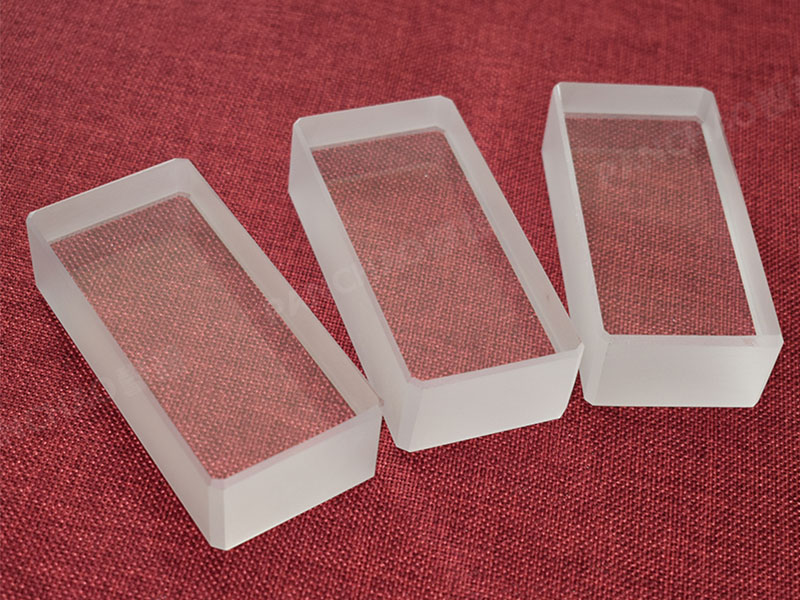Why Is the Glass Moldy
Click:
-Time:2022-08-20 16:39
Moldy condition: the glass surface is not flat and under long-term dark conditions.

Cause of moldiness: initially, water or moisture is adsorbed on the surface of the glass, and then water or moisture diffuses into the glass. The soluble silicate in the surface layer is hydrolyzed and destroyed. First, sodium silicate and potassium silicate are hydrolyzed and destroyed to form NaOH and silica. The silica gel formed by the separated silica forms a protective film on the glass surface to prevent further erosion. NaOH formed by hydrolysis reacts with carbon dioxide in the air to form sodium carbonate, which is collected on the glass surface to form the soluble salt in the surface facial mask. Because of its strong water absorption, it deliquesces and finally forms alkali droplets. When the temperature and humidity around it change, these alkali droplets also change. If these alkali droplets are in contact with the glass for a long time, part of the gel like silicon oxide film will be dissolved, causing serious local erosion on the glass surface and forming spots. At this time, sodium ions will migrate out of the glass body and react with the air to form white alkali rich particles, which can be observed by scanning electron microscope.

Cause of moldiness: initially, water or moisture is adsorbed on the surface of the glass, and then water or moisture diffuses into the glass. The soluble silicate in the surface layer is hydrolyzed and destroyed. First, sodium silicate and potassium silicate are hydrolyzed and destroyed to form NaOH and silica. The silica gel formed by the separated silica forms a protective film on the glass surface to prevent further erosion. NaOH formed by hydrolysis reacts with carbon dioxide in the air to form sodium carbonate, which is collected on the glass surface to form the soluble salt in the surface facial mask. Because of its strong water absorption, it deliquesces and finally forms alkali droplets. When the temperature and humidity around it change, these alkali droplets also change. If these alkali droplets are in contact with the glass for a long time, part of the gel like silicon oxide film will be dissolved, causing serious local erosion on the glass surface and forming spots. At this time, sodium ions will migrate out of the glass body and react with the air to form white alkali rich particles, which can be observed by scanning electron microscope.
Treatment method: Sprinkle mold proof powder on the glass surface.
If you are interested in the or need to consult, please call us +8613569413718.Pan Chao special industrial glass, Customize your persoalised glass products.
Welcome sending your inquiry: Phone :+8613569413718 Email: info@panchaoglass.com
If you are interested in the or need to consult, please call us +8613569413718.Pan Chao special industrial glass, Customize your persoalised glass products.
Welcome sending your inquiry: Phone :+8613569413718 Email: info@panchaoglass.com
Related articles
- How to Maintain Tempered Glass
- What is the LOW-E glass?
- Characteristics of plexiglass
- Overview of Application Methods of High Temperature Resistant
Recommend
- How to Maintain Tempered Glass
- Why Is the Glass Moldy
- What Are the Advantages of Low-E Glass?
- What is the LOW-E glass?
- Characteristics of plexiglass
- Comparison between Semi Tempered Glass and Tempered Glass
- Rectification and Purification of Ultra High Temperature Resi
- Overview of Application Methods of High Temperature Resistant
- Adsorption and Purification of Ultra High Temperature Resista
- Calculation Formula of Bending Strength of Pressure Resistant
Rank
- Application of high temperature resistant glass
- Precautions in the process of quartz tube cutting and picklin
- What Glass Has the Highest Temperature Resistance
- What are the advantages and disadvantages of quartz tube heat
- ultra-thick tempered sight glass for submarine
- The process of toughening of borosilicate tempered sight glas
- Where is high pressure resistant glass used?
- The difference between high borosilicate glass, medium borosi
- Introduction of elliptical quartz tube and oval quartz tube
- Introduction to the Characteristics of Quartz Glass Tube 1
Latest articles
- How to Maintain Tempered Glass
- Why Is the Glass Moldy
- What Are the Advantages of Low-E Glass?
- What is the LOW-E glass?
- Characteristics of plexiglass
- Comparison between Semi Tempered Glass and Tempered Glass
- Rectification and Purification of Ultra High Temperature Resi
- Overview of Application Methods of High Temperature Resistant
- Adsorption and Purification of Ultra High Temperature Resista
- Calculation Formula of Bending Strength of Pressure Resistant

